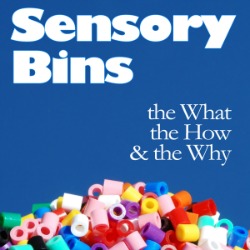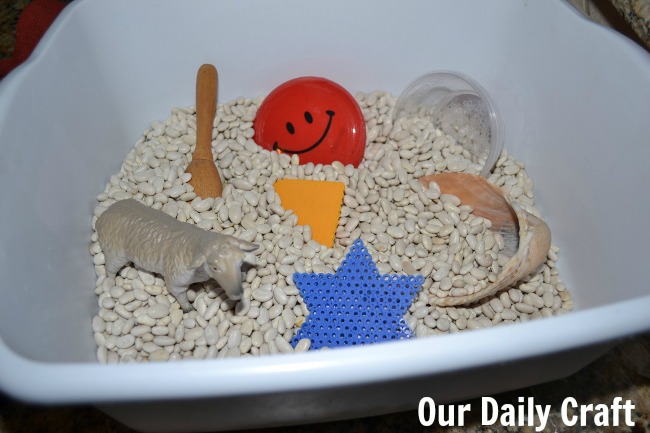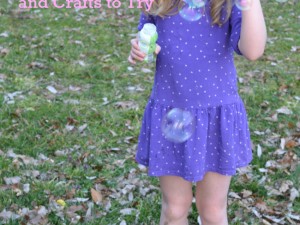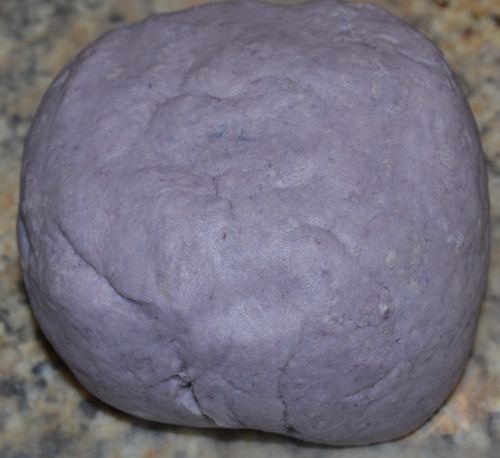Affiliate links may be included for your convenience. View our privacy and affiliates policy for details.
This is just the week of looking back at crafty, sensory things we used to love, I guess. Following my report on getting back into water beads (they’ve been out all week in the playroom; we’ve been observing how they plump up more when sitting in water) an online colleague announced she’d just written an ebook about sensory bins (affiliate link) and I offered to take a look.
Sharla Kostelyk blogs at The Chaos and the Clutter (boy, that sounds familiar) and is a contributor, like me, at Not Consumed (incidentally, my post for this month is live, and it’s a great lesson about how crafting can be a gateway to talking to your kids about serious things). She’s a super-busy mom of seven kids, five of whom were adopted, and four of whom have Sensory Processing Disorder (and one has Asperger’s).
She’s not a childhood development expert, but she is an expert in what works for her kids, and she’s found that using sensory boxes with them has been helpful. She reports that all of her kids have fun with them, and they’re a popular part of the homeschool classroom, but they also seem to help the kids with sensory problems to calm down and focus better.
It may seem like they’re just a random collection of things, but they can do really important work, as she writes:
Sensory bins are designed to encourage discovery and exploration through the senses, so when creating a bin, you want to keep in mind things that encourage: squeezing, pinching, tasting, smelling, organizing, exploring, scooping, creating, trying, pouring, spooning, grasping, pounding, measuring, stirring, manipulating materials, listening, imagining, separating, adding, trying, learning, guessing, touching, and having fun.
I know that the Bit really used to like the sensory bins I made for her (pompoms was probably my favorite, but the Easter one was fun, too). I don’t know why I stopped making them, but this book inspired me to put another one together, which we’ll talk about in a minute.
How to Make a Sensory Bin
While I wish the book did go into a little bit more of the benefits of sensory play, it is a good guide to the basics of putting a bin together and the sorts of materials you might want to use. If you’ve never made a sensory bin before and don’t know where to start, this book will help.
Long lists of items to use as containers, base materials and other items to put in the tub are helpful and will give you some ideas you might not have tried before even if you are a fan of the bins. For instance, before reading this book I’d never made a bin with beans as the base, but now I have.
It also encourages you to use what you have and buy items on sale or at the dollar or discount store, so you see that you don’t have to spend a fortune to engage your child in this kind of play. There are also links to her family’s favorite sensory bins in the ebook, but I would have liked it if there had been some sample bins included in the book just so you didn’t have to go online to look at them.
Why Sensory is Important
If you, too, are interested in the benefits of sensory play, I did a little research and found a great article at PBS that lists a range of benefits, including:
- improved problem solving and decision making
- using descriptive language
- being completely in control of their actions
- developing fine motor skills
- providing open-ended, creative play time
Amanda at Not Just Cute says sensory exploration is a part of the scientific process and a way for kids to learn about the world on a small scale, and it’s just plain fun for kids and adults alike. It’s an easy way for you to be creative, too, as you gather materials and try to think about ways to engage all of your child’s senses (well, I usually skip taste) with a bin.
My New Sensory Bin

While reading this book I was inspired to try out a new sensory bin, and I wanted to show you that you can do it with minimal materials and in a short amount of time.
This bin isn’t really finished, but you get the idea. I bought a four-pound bag of beans at the grocery store (I think it cost about $4), used a plastic tub we already had, then walked around the kitchen and the Bit’s room and picked up a few little things to put in there:
- a shell
- a couple of perler bead shapes
- a small frisbee
- a goat toy
- a couple of plastic cups
- a wooden thing that I think is for darning socks
There’s no real theme to these things, but I was looking for different shapes, colors, textures and materials. It’s always good to have containers, scoops and whatnot, but she has ready access to that sort of thing should she want more. I was thinking of making this a farm scene and adding a little barn puzzle piece, a couple of more animals, maybe some letter or number magnets just for fun. I don’t know.
The point, however, is that these are really pretty quick and easy to do, and might give you a spare few minutes to load the dishwasher or get dinner started while your kids are engaged in really important play. If you want to give it a try, I encourage you to check out Sharla’s book (affiliate link) and try some of her ideas.
Do you already use sensory bins? I’d love to know what’s been a hit for your kids!



